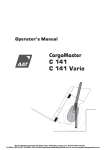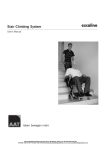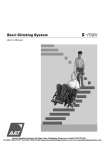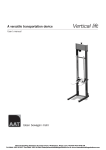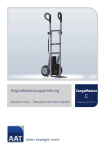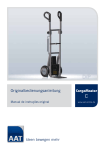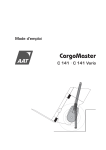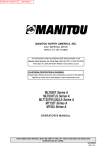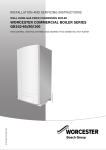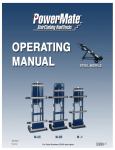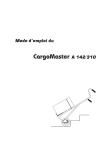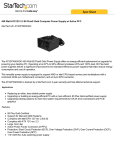Download CargoMaster A 142/310 - Manual Handling Solutions
Transcript
Operator’s Manual CargoMaster A 142/310 Manual Handling Solutions 58, Paige Close, Watlington, Kings Lynn, Norfolk PE33 0TQ UK Tel 0044 1553 811977 Fax 0044 1553 811004 [email protected] www.manualhandlingsolutions.com CargoMaster 1 Table of Contents 2. Introduction 3. Brief Survey 3.1 General Information 3.2 Functional Concept 3.3 Functional Sequence 3.4 Description A142 3.5 Description A310 4. Before Using the CargoMaster 4.1 Checking the Safety Brakes 5. Operating the CargoMaster 5.1 Safety Instructions 5.2 Parking Without a Load 5.3 Parking With a Load 5.4 Moving on Level Ground 5.5 Adjusting the Handlebars 5.6 Picking up Loads 5.7 Loading with the Adjustable Toe Plate (A 310 only) 5.8 Loading a Vehicle 5.9 Unloading a Vehicle 5.10 Climbing Upstairs 5.11 Climbing Downstairs 5.12 Adjustable climbing speed 6. Accessories 6.1 Horizontal Platform 6.2 Supporting Frame (only applicable to A310) 6.3 Portable Stairs 6.4 Spare Batteries 7. Maintenance 7.1 General Information 7.2 Changing the Electrical Fuses 7.3 Changing the Batteries 8. Lead Batteries 8.1 General Information 8.2 Charging the Lead Batteries 9. Problems and Solutions 10. Warranty and Liability 10.1 Warranty 10.2 Liability 142/310GB 5/99 11. Appendix Noise and Vibrations Declaration of CE Conformity Note Manual Handling Solutions 58, Paige Close, Watlington, Kings Lynn, Norfolk PE33 0TQ UK Tel 0044 1553 811977 Fax 0044 1553 811004 [email protected] www.manualhandlingsolutions.com CargoMaster 2 Introduction Congratulations, you acquired a powerful and versatile machine to transport loads. The CargoMaster will shortly be an indispensable help to you. However, in order to transport heavy loads effortlessly upand downstairs, it is necessary to acquire a certain skill in using the CargoMaster. For this reason we ask you to read the operator’s manual carefully and pay particular attention to all warning and safety instructions before using the CargoMaster for the first time. We further suggest that, in order to get used to this stairclimbing device, you practise handling it first without loads. For safety reasons it is mandatory to observe strictly the maximum limit for loads. The warranty does not cover damage due to exceeding the maximum load or to inappropriate handling, e.g.: warped axles • warped frames • warped handlebars or grips 142/310GB 5/99 • Manual Handling Solutions 58, Paige Close, Watlington, Kings Lynn, Norfolk PE33 0TQ UK Tel 0044 1553 811977 Fax 0044 1553 811004 [email protected] www.manualhandlingsolutions.com CargoMaster 3 3.1 Brief Survey General Information Everybody who sees the CargoMaster in action for the first time is fascinated by its climbing mechanism. Precisely those people who are technically inclined end up shaking their heads as they try to understand how it works. If one did not see the CargoMaster actually climb up- and downstairs, one would reach the conclusion that this couldn’t possibly work, and yet it does. A 3.2 The Functional Principle The major focus lies at the axle (F) at the frame (A) of the CargoMaster, around which the lifting levers (E) together with the big wheels (C) rotate (see 3.3 “Functional Sequence”). B F E C D FIGURE 1 The big wheels are not powered; instead they rotate freely on the motor shaft. The small supporting wheels (B) are also not powered but rotate freely. The lifting levers are fixed to the motor shaft by means of teeth. If the motor rotates, then the lifting levers inevitably also rotate around the axis (D), which is both the axis of the motor shaft as well as of the not powered big wheels. The other ends of the lifting levers, as described previously, rotate freely around the axis (F) attached to the frame of the CargoMaster. This free rotation inevitably results in the climbing process’ intended up or down movement of either the big wheels or the frame of the CargoMaster on the stairs. Depending on the constellation of the frame, lifting levers, and big wheels to each other certain positions follow in which one can either drive or park the CargoMaster. F D FIGURE 2 142/310GB 5/99 How one can use the up and down movement of the big wheels and the frame of the CargoMaster to climb stairs is shown and described in detail as follows. Manual Handling Solutions 58, Paige Close, Watlington, Kings Lynn, Norfolk PE33 0TQ UK Tel 0044 1553 811977 Fax 0044 1553 811004 [email protected] www.manualhandlingsolutions.com CargoMaster 3.3 Functional Sequence For the purpose of describing the functional sequence, please assume that the CargoMaster is in the position “moving on level ground.” More precisely, the moving gear and the frame are in such a position to each other that one can easily drive on level ground. This starting position of the CargoMaster is called 0°. The lifting levers are in an approximately horizontal position as shown in Figure 3. The rotating axis of the lifting levers and the axles of the big wheels are on about the same level. The First Phase FIGURE 3 Drive the CargoMaster to the first step of the stairs in the position 0°. Push the up/down switch to “UP” and the motor begins to rotate. The motor shaft can rotate freely in the big wheels and, since the lifting levers are connected with the motor shaft, the lifting levers rotate around the axis of the big wheels, which, in turn, inevitably lifts the frame. The rotation moves from 0° to 45° and at position 90° one can see that the lifting levers lifted the frame into its highest possible position. The small supporting wheels climbed along and touch down on the next step at approximately 135° (see Figure 4). This concludes the first phase. 0° 90° 45° 135° FIGURE 4 The Second Phase Once the supporting wheels touched down on the step, the big wheels are moved up to the same step passing the positions 180° and 225° (see Figure 5). 180° 225° 270° 315° 360° FIGURE 5 142/310GB 5/99 At roughly 270° the big wheels reach their highest possible position and at about 315° they take over the load of the small supporting wheels. In the meantime one pulls the CargoMaster back to the edge of the following step. The final position 360° coincides with the starting position 0°, which concludes the second phase and the process can be repeated. Manual Handling Solutions 58, Paige Close, Watlington, Kings Lynn, Norfolk PE33 0TQ UK Tel 0044 1553 811977 Fax 0044 1553 811004 [email protected] www.manualhandlingsolutions.com CargoMaster 1 3.4 Description A 142 1 = Handlebars 2 2 = Up/Down Switch 3 = Control Knob for Speed 5 4 = On/Off Switch 3 4 5 = Safety Belt 6 = Battery 13 7 = Toe Plate 8 = Safety Brakes 9 = Big Wheels 12 10 = Supporting Wheels 12 = Fuses 13 = Fastening Lever 6 11 11 = Fuse 7 10 8 9 8 FIGURE 6 Technical Data: A 142 Height: 1120 mm Dimensions Width: 580 mm Depth: 470 mm Handlebars extendible up to 1770 mm Weight Frame 26 kg, Batteries 6 kg Lifting Capacity 140 kg Sealed Batteries 2 x 12 V / 7,2 Ah (sealed) DC Motor 24 V Climbing Rate 8 - 25 steps per minute, adjustable 142/310GB 5/99 Capacity with one charge of the batteries 30 - 50 floors, depending on the load Manual Handling Solutions 58, Paige Close, Watlington, Kings Lynn, Norfolk PE33 0TQ UK Tel 0044 1553 811977 Fax 0044 1553 811004 [email protected] www.manualhandlingsolutions.com CargoMaster 1 3.5 Description A 310 1 = Handlebars 2 3 2 = Up/Down Switch 4 3 = Control Knob for Speed 4 = On/Off Switch 15 5 = Safety Belt 5 14 6 = Battery 7 = Toe Plate 8 = Big Wheels 6 13 9 = Safety Brake 12 10 = Supporting Wheels 11 11 = Stop bolts for toe plate 12 = Fuse 10 13 = Fuses 14 = Fastening screw knobs 7 15 = Push handles 9 Technical Data: 8 A 310 Height: 1130 mm Dimensions Width: 590 mm Depth: 520 mm Handlebars extendible up to 1800 mm Weight Frame 40 kg, Batteries 6 kg Lifting Capacity 310 kg Sealed Batteries 2 x 12 V / 7,2 Ah (sealed) DC Motor 24 V Climbing Rate 4 - 10 steps per minute, adjustable 142/310GB 5/99 Capacity with one charge of the batteries 15 -30 floors, depending on the load Manual Handling Solutions 58, Paige Close, Watlington, Kings Lynn, Norfolk PE33 0TQ UK Tel 0044 1553 811977 Fax 0044 1553 811004 [email protected] www.manualhandlingsolutions.com CargoMaster 4 Before Operation Before you use the CargoMaster for the first time, please make sure the batteries are completely charged, as shown in chapter 8.2 Charging the Lead Batteries. + 4.1 Please check the safety brakes each time before you use the CargoMaster. Checking the Safety Brakes First, put the CargoMaster in the parking position by pushing the up/down switch, as shown in Figure 10. FIGURE 10 Then, tilt the machine so far towards you that the loading surface of the frame is almost in a horizontal position; this movement lifts the big wheels off the ground, so that only the small supporting wheels still touch the ground. At this point the safety brakes hinge down, engage and block the supporting wheels as shown in Figure 11. If the machine cannot be pushed forward, but only rolled backward, then the braking effect for a safe use of the CargoMaster is achieved. FIGURE 11 If this braking effect does not set in, the CargoMaster may not be used under any circumstances. Please contact your local dealer or the manufacturer immediately. 142/310GB 5/99 + àà Manual Handling Solutions 58, Paige Close, Watlington, Kings Lynn, Norfolk PE33 0TQ UK Tel 0044 1553 811977 Fax 0044 1553 811004 [email protected] www.manualhandlingsolutions.com CargoMaster 5 5.1 Operating the CargoMaster Safety Instructions For the safe operation of the CargoMaster, it is imperative to observe all requests for caution and all instructions of the operator´s manual as well as all safety measures and instruction labels on the machine itself. + + + + + The CargoMaster may only be used by a trained person. During operation, never put your hand underneath the loading shovel. Check the safety brakes before each time you use the machine. The maximum load, see label on the machine, may never be exceeded. Each load you transport must be secured with the safety belt. + If any of the power-driven elements of the CargoMaster lock, turn off the machine immediately. + + Never transport people with the CargoMaster. Only operate the CargoMaster in conjunction with the safety devices that belong to the particular machine. + Please turn off the CargoMaster, i.e. put the power switch in position O, when you stop the machine or take a break in transporting a load. + Repair work on the CargoMaster may only be done by the manufacturer or authorized dealers. + + + People under age are not allowed to operate the CargoMaster (except those over 16 who are trained under supervision). Make sure that the fastening screw knobs or fastening levers of the handlebars are always securely tightened, particularly after adjusting the handlebars. Make sure that the lead batteries are recharged after each operation. 142/310GB 5/99 + Only use original spare parts by AAT Alber Antriebstechnik GmbH. Manual Handling Solutions 58, Paige Close, Watlington, Kings Lynn, Norfolk PE33 0TQ UK Tel 0044 1553 811977 Fax 0044 1553 811004 [email protected] www.manualhandlingsolutions.com CargoMaster 5.2 Parking Without a Load Put the wheels in such a position as shown in Figure 12; then park the CargoMaster by resting it on the loading shovel like a regular sack trolley. FIGURE 12 5.3 Parking With a Load To park the CargoMaster with a load safely, all four wheels, that is the big wheels and the small supporting wheels, must touch the ground. Ideally the load´s center of gravity is between the big wheels and the smaller supporting wheels as shown in Figure 13. If this is not the case, one can shift the load accordingly, provided that your type of CargoMaster is equipped with an adjustable loading shovel as shown in chapter 5.7. If your machine has a fixed loading shovel, you can insert a wooden block or something similarly suitable under the load. / FIGURE 13 142/310GB 5/99 The position of the load´s center of gravity determines the angle of inclination in which the CargoMaster plus load are balanced in the park position, in other words, the equilibrium is retained and the CargoMaster rests securely on the floor. Manual Handling Solutions 58, Paige Close, Watlington, Kings Lynn, Norfolk PE33 0TQ UK Tel 0044 1553 811977 Fax 0044 1553 811004 [email protected] www.manualhandlingsolutions.com CargoMaster 5.4 Moving on Level Ground Push the up/down switch and bring the moving gear in such a position as shown in Figure 14. The lifting levers are in a roughly horizontal position and point backward in reference to their axis of rotation on the frame. FIGURE 14 5.5 Adjusting the Handlebars In order to drive, take up loads, and climb stairs with as little effort as possible, the handlebars of the CargoMaster should be adjusted to the operator’s height. For the most comfortable and safe way to use the CargoMaster, adjust the height of the handlebars to height of the operator’s shoulders, as shown in Figure 15. Depending on your type of CargoMaster, adjust the handlebars by loosening either the fastening levers or the fastening screw knobs on the frame and push the handlebars into the desired direction. Make sure that the handlebars are always sufficiently inserted into the frame, that is, do not pull them out too far. With models featuring round pipe handlebars this is guaranteed, if the slits in the clamping pipes of the frame are always filled out by the handlebars. With models featuring rectangular pipe handlebars, such as model A 281, stop bolts keep you from pulling out the handlebars too far. With these models stop bolts also lock the handlebars, even if they are completely pushed in. After adjusting the handlebars, always make sure that they are securely fastened. FIGURE 15 142/310GB 5/99 + Manual Handling Solutions 58, Paige Close, Watlington, Kings Lynn, Norfolk PE33 0TQ UK Tel 0044 1553 811977 Fax 0044 1553 811004 [email protected] www.manualhandlingsolutions.com CargoMaster 5.6 Picking up Loads Put the wheels in the position shown in Figure 16 and move the shovel of the CargoMaster under the load you want to transport. FIGURE 16 + Secure the load with the safety belt (see Figure 17). FIGURE 17 You pick up the load by pushing your foot against the plastic plate of the driving unit - the other foot rests firmly on the ground - while pulling at the handlebars tilting the CargoMaster with its load toward you. It is easier to pull at the bow than at the top of the handles 142/310GB 5/99 + Manual Handling Solutions 58, Paige Close, Watlington, Kings Lynn, Norfolk PE33 0TQ UK Tel 0044 1553 811977 Fax 0044 1553 811004 [email protected] www.manualhandlingsolutions.com CargoMaster 5.7 Picking up Loads with the Height-Adjustable Toe Plate (A 310 only) If your CargoMaster is equipped with the optional, height-adjustable shovel, you need to put the shovel in the position at which the load’s center of gravity is positioned between the big wheels and the smaller supporting wheels as described in the chapter 5.3 “Parking with a Load.” To adjust the height-adjustable toe plate, unlock the particularly provided spring-urged stop bolts (see Figure 19). FIGURE 19 Pull out the stop bolt as shown in Figure 20. FIGURE 20 Turn it by 90° (see Figure 21), at which point the stop bolt snaps into a small indentation securing it against turning at its own. FIGURE 21 Adjust the shovel to the appropriate position and turn the stop bolts again by 90°, at which point they snap back into their groove. You might have to slide the shovel back and forth in its guiding device to make sure that the stop bolts snap into their grooves securely. The nose must be fully inserted into the groove, see Figure 19 142/310GB 5/99 + FIGURE 22 Manual Handling Solutions 58, Paige Close, Watlington, Kings Lynn, Norfolk PE33 0TQ UK Tel 0044 1553 811977 Fax 0044 1553 811004 [email protected] www.manualhandlingsolutions.com CargoMaster 5.8 Loading of a Vehicle Drive straight to the edge of the loading platform and bring the CargoMaster with its load into the parking position as shown in Figure 23. Then loosen the safety belts. FIGURE 23 Bring the CargoMaster in its highest possible position. à Drive the CargoMaster to the edge of the vehicle’s loading platform as shown in Figure 24 and tilt the load onto it. FIGURE 24 For your safety and convenience we recommend to use the AAT Alber portable stairs (see 6.3 “Portable Stairs”) when loading platforms. 142/310GB 5/99 + Manual Handling Solutions 58, Paige Close, Watlington, Kings Lynn, Norfolk PE33 0TQ UK Tel 0044 1553 811977 Fax 0044 1553 811004 [email protected] www.manualhandlingsolutions.com CargoMaster 5.9 Unloading of a Vehicle à Push the load as far as possible over the edge of the loading platform. Bring your CargoMaster into its highest possible position, see Figure 25, and drive with the shovel as closely as possible under the load to the edge of the loading platform. Then tilt the load onto the CargoMaster. FIGURE 25 Put the CargoMaster in park position and secure the load with the safety belt as shown in Figure 26. FIGURE 26 For your safety and convenience we recommend to use the AAT Alber portable stairs (see 6.3 “Portable Stairs”) when loading platforms. 142/310GB 5/99 + Manual Handling Solutions 58, Paige Close, Watlington, Kings Lynn, Norfolk PE33 0TQ UK Tel 0044 1553 811977 Fax 0044 1553 811004 [email protected] www.manualhandlingsolutions.com CargoMaster 5.10 Climbing Upstairs You will manage the climbing process without problems and in next to no time, if you follow instructions closely. At first you should practice climbing stairs up and down with the CargoMaster without loads to get familiar with the device and how it works. 1. To climb stairs, drive with the CargoMaster backwards toward the stairs and climb 2 to 3 steps. Please make sure that the CargoMaster´s big wheels are touching the edge of the lowest step as shown in Figure 27. + FIGURE 27 During the entire climbing process, always pull the CargoMaster slightly backwards towards you, i.e. keep the device always under tensible force. 2. Push the up/down switch to “UP“ initiating the climbing process. The motor and the lifting levers begin to rotate and uplift the frame plus load (see Figures 28 and 29). + FIGURE 28 FIGURE 29 Imitate this powered climbing process of the frame with your arms and consequently with the handlebars. Hereby you keep the CargoMaster in a sufficiently steep angle so that the supporting wheels can touch down on the next higher step. 3. The climbing process takes place in two 142/310GB 5/99 sections per step. The first section is finished when the small supporting wheels touch down on the next step (see Figure 30) and take over the load from the big wheels. FIGURE 30 Manual Handling Solutions 58, Paige Close, Watlington, Kings Lynn, Norfolk PE33 0TQ UK Tel 0044 1553 811977 Fax 0044 1553 811004 [email protected] www.manualhandlingsolutions.com CargoMaster 4. At this point a load alternation takes place. You can clearly feel a pull forward at the handlebars. Compensate this movement of the CargoMaster by pushing the handlebars downward, thus decreasing its angle of inclination as shown in Figure 31. + Make sure the handlebars are not held too low because in such case the supporting wheels do not reach the next higher step. FIGURE 31 5. The second section begins with the lifting or pulling up of the big wheels as shown in Figure 32; it is finished when the big wheels touch down, next to the small supporting wheels, on the following step. At this point there is another load alternation, which is compensated, in turn, by lifting the handlebars holding the CargoMaster at a steeper angle. FIGURE 32 142/310GB 5/99 By keeping the CargoMaster always slightly under tensible force, it rolls automatically to the next step (see Figure 33). The climbing process repeats itself as described above. FIGURE 33 Manual Handling Solutions 58, Paige Close, Watlington, Kings Lynn, Norfolk PE33 0TQ UK Tel 0044 1553 811977 Fax 0044 1553 811004 [email protected] www.manualhandlingsolutions.com CargoMaster 5.11 Climbing Downstairs + Notice that only the small supporting wheels are equipped with brakes; the big wheels don’t have brakes.. 1. Bring the big wheels in the position as shown in Figure 34 and rest the CargoMaster on its small supporting wheels by pushing the handlebars down. Hold the device precisely at such a position that the big wheels do not touch the ground anymore. FIGURE 34 2. Push the CargoMaster all the way up to the edge of the step until the braking wheels just reach over said edge (see Figure 35); however, the safety brakes should not be activated. FIGURE 35 142/310GB 5/99 + Do not use the safety brakes as a kind of “stopper.“ The safety brakes are intended, if the case arises, to keep the small supporting wheels from rolling over the edge of the step. Manual Handling Solutions 58, Paige Close, Watlington, Kings Lynn, Norfolk PE33 0TQ UK Tel 0044 1553 811977 Fax 0044 1553 811004 [email protected] www.manualhandlingsolutions.com CargoMaster 3. Push the up/down switch to “DOWN“ — the CargoMaster starts its descent. The downward movement begins with the lowering of the big wheels to the next step (see Figure 36). FIGURE 36 + FIGURE 37 As soon as the big wheels touch down on the next lower step (see Figure 37), pull the CargoMaster slightly toward you. 4. After the big wheels touched down on the next step, the frame lowers itself (see Figure 38) until the small supporting wheels touch down next to the big wheels (see Figure 39) FIGURE 38 FIGURE 39 5. As soon as the small supporting wheels also touch down on the step, push the device forward until it reaches the edge of the step (see Figure 40); from now on the downward movement repeats itself. Please go back to point 2. 142/310GB 5/99 FIGURE 40 Manual Handling Solutions 58, Paige Close, Watlington, Kings Lynn, Norfolk PE33 0TQ UK Tel 0044 1553 811977 Fax 0044 1553 811004 [email protected] www.manualhandlingsolutions.com CargoMaster 5.12 Adjustable Climbing Speed The climbing speed can be adjusted with the speed control knob (see 3.4 “Description”) Note that the CargoMaster is equipped with an automatic turn off function. Once the device has turned itself off (e.g. during a break) you need to turn the CargoMaster first off and then on again with the ON/OFF switch. 142/310GB 5/99 + Manual Handling Solutions 58, Paige Close, Watlington, Kings Lynn, Norfolk PE33 0TQ UK Tel 0044 1553 811977 Fax 0044 1553 811004 [email protected] www.manualhandlingsolutions.com CargoMaster 6 6.1 Accessories Platform max. 130 kg The platform makes the transport of loads such as e.g. copy machines in a close to horizontal position possible. This platform can be easily attached to the CargoMaster (except for type 010 without tools. You simply hook it into the two specifically provided, drilled holes in the frame of the CargoMaster and unfold the supports, which you put into the edge of the loading shovel as shown in Figure 41. FIGURE 41 The load’s weight on the platform may not exceed 130 kg. 142/310GB 5/99 + Manual Handling Solutions 58, Paige Close, Watlington, Kings Lynn, Norfolk PE33 0TQ UK Tel 0044 1553 811977 Fax 0044 1553 811004 [email protected] www.manualhandlingsolutions.com CargoMaster 6.2 Supporting Frame (only for model A310) The handling of particularly heavy and bulky loads such as e.g. heating boilers becomes easier with the help of the supporting frame. 1. Unfold the handlebar’s rest on the supporting frame and lock it. 2. Take up the load, e.g. a heating boiler, as usual and drive with the CargoMaster A310 in front of the supporting frame as you would in front of the first step of stairs. 3. Now let the small supporting wheels climb onto the supporting frame as you would on a step and put down the handlebars of the CargoMaster as shown in Figure 42. FIGURE 42 4. Unlock the loading shovel’s stop bolts and pull it out of the frame entirely (see Figure 43). FIGURE 43 5. Figure 44 shows how to wheel the supporting frame plus its load right in front of the foundation on which you’d like the heating boiler. 6. 142/310GB 5/99 By pushing the up/down switch, level the height of the CargoMaster with the height of the foundation in order to push the heating boiler on it (see Figure 44). FIGURE 44 Manual Handling Solutions 58, Paige Close, Watlington, Kings Lynn, Norfolk PE33 0TQ UK Tel 0044 1553 811977 Fax 0044 1553 811004 [email protected] www.manualhandlingsolutions.com CargoMaster 6.3 Portable Stairs 45 A D 0 Bm 0m The portable stairs are especially developed for the CargoMaster to overcome obstacles higher than 50 cm (~20") such as e.g. ramps, platforms or loading areas of trucks (see Figure 45). C FIGURE 45 Technical Data portable stairs 0 42 number of steps 3 height of loading area (C) from 30 cm to max. 52 cm maximum dynamic load (D) 350 kg protrusion (A) 80 cm minimum support (B) 15 cm weight 12,5 kg + 4 from 52 cm to max. 66 cm 350 kg 100 cm 15 cm 16,5 kg The portable stairs must be put up securely, i.e. you need to make sure it cannot tilt or slide. If necessary, you need to screw it on the loading area. Make sure that the minimum support (15 cm, ~20") of the portable stairs rests securely on the loading area. 142/310GB 5/99 + 0 43 Manual Handling Solutions 58, Paige Close, Watlington, Kings Lynn, Norfolk PE33 0TQ UK Tel 0044 1553 811977 Fax 0044 1553 811004 [email protected] www.manualhandlingsolutions.com CargoMaster 6.4 Spare Batteries (optional) If you need your CargoMaster continuously, i.e. if there are not enough breaks to recharge the batteries, we recommend you get a spare set of batteries. While one set is in use, the second set can be recharged. + To charge the batteries, please use the AAT Alber battery charger exclusively. Note that the CargoMaster is equipped with an automatic turn off function. Once the device has turned itself off (e.g. during a break) you need to turn the CargoMaster first off and then on again with the ON/OFF switch. 142/310GB 5/99 + + In order to prolong its lifetime, the spare set of batteries should always be connected to the battery charger (see chapter 7 “Care and Maintenance”) Manual Handling Solutions 58, Paige Close, Watlington, Kings Lynn, Norfolk PE33 0TQ UK Tel 0044 1553 811977 Fax 0044 1553 811004 [email protected] www.manualhandlingsolutions.com CargoMaster 7 7.1 Care and Maintenance General Information Your CargoMaster is not a maintenance-intense device. On the contrary, it is easy to take care of. Clean it now and then with a moist (not wet) cloth. The lead batteries are maintenance-free. + 7.2 Repairs and work done on the CargoMaster are to be performed by authorized personnel only. Changing the Electrical Fuses The electrical fuses are located on the left side of the batteries as well as on the right side of the driving unit (see 3.4 “Description”). You can easily remove the fuse holders with a screwdriver. 7.3 Changing the batteries Unscrew all the screws of the battery pack, unplug the contact plugs and take out the batteries. Please pay attention to the polarity when plugging in the contacts plugs of the new batteries. 142/310GB 5/99 + Manual Handling Solutions 58, Paige Close, Watlington, Kings Lynn, Norfolk PE33 0TQ UK Tel 0044 1553 811977 Fax 0044 1553 811004 [email protected] www.manualhandlingsolutions.com CargoMaster 8 8.1 Lead Batteries General Information The two lead batteries of your CargoMaster are maintenance-free, rechargeable and of top quality. The lifetime of the lead batteries is largely dependent on the charging and discharging cycles, i.e. if total discharges can be avoided, one is able to get far more than 1000 partial discharges and over 200 times the full capacity out of lead batteries. Total discharges of lead batteries do not only lead to a loss of capacity but also to a lower lifetime of the batteries. Avoid total discharges — never leave the CargoMaster switched on. The CargoMaster´s lead batteries are supposed to be recharged after each partial discharge, i.e. after each use. Lead batteries are subject to the so-called self-discharge. Therefore, whenever possible, the lead batteries should always be connected to the Alber Automatic Charger. As soon as the batteries are fully charged, the charger automatically switches to the retaining of the charge, which keeps the lead batteries from becoming overcharged. If lead batteries are stored for a longer period of time without being charged, they suffer a partial loss of capacity. However, after a few cycles of charging and discharging, they regain their full capacity. Your CargoMaster´s lead batteries can be charged or dis-charged in any position. They are considered as safe as dry elements and admitted for air travel by DOT and IATA. Charging your lead batteries is a vital part of taking care of them. 142/310GB 5/99 + Manual Handling Solutions 58, Paige Close, Watlington, Kings Lynn, Norfolk PE33 0TQ UK Tel 0044 1553 811977 Fax 0044 1553 811004 [email protected] www.manualhandlingsolutions.com CargoMaster 8.2 Charging the Lead Batteries In order to charge the batteries, you have to remove the batteries from the CargoMaster. Plug the plug of the charger into the socket on the bottom side of the batteries. + Please always make sure to charge or recharge the maintenance-free lead batteries after each use of the CargoMaster. The lead batteries can be charged either in your vehicle by plugging the charging cable into the socket of your cigarette lighter or from a wall outlet by using the Alber charger. If you charge them in your car, you reach approximately 80% of their capacity, otherwise 100%. + Please use exclusively the special AAT Alber Automatic Charger and the AAT Alber charging cable for the car. As soon as the batteries are fully charged, the Alber Automatic Charger switches to retaining of the charge, which means that overcharging is impossible. Never let the CargoMaster sit with empty lead batteries, but charge them immediately after each use. Frequent charging prolongs their lifetime. + In order to retain the charge, always keep your CargoMaster connected to the Alber Automatic Charger, particularly during weekends, holidays or vacations. This does not damage the batteries, on the contrary, it prolongs their lifetime. 142/310GB 5/99 + Manual Handling Solutions 58, Paige Close, Watlington, Kings Lynn, Norfolk PE33 0TQ UK Tel 0044 1553 811977 Fax 0044 1553 811004 [email protected] www.manualhandlingsolutions.com CargoMaster 9 Problems and Solutions If the case should arise that your CargoMaster, due to unpredictable reasons, does stop working while climbing stairs, the following could be wrong: 1. The lead batteries are empty. l In such case, wait for 20 to 30 seconds. During that brief time span the lead batteries can recuperate sufficiently to make at least descending of the stairs possible because that takes very little energy. 2. Technical failure l Depending on the situation, do as follows: l a) If the device rests on its small supporting wheels on a step, put it down backwards on the stairs and remove the load. l b) If the device rests on its big wheels on a step, you can use the CargoMaster like a regular trolley. + + The reason for the CargoMaster´s failure can be the burning of a fuse due to overloading. Should this be the case, the problem is easily solved by simply changing the 30 A fuse. The trip line of the up/down switch is protected by a 2 A fuse. If the 2 A fuse burns, the switch and the trip line have to be checked. 142/310GB 5/99 If the problem is not solved by substituting the fuses, please contact your local AAT Alber dealer. Manual Handling Solutions 58, Paige Close, Watlington, Kings Lynn, Norfolk PE33 0TQ UK Tel 0044 1553 811977 Fax 0044 1553 811004 [email protected] www.manualhandlingsolutions.com CargoMaster 10 Warranty and Liability 10.1 Warranty AAT Alber Antriebstechnik GmbH takes over the warranty of their products type CargoMaster and all accessory parts, with the exception of the lead batteries, for the time period of one year starting with the date you receive your device. During that time AAT Alber Antriebstechnik GmbH guarantees that the above listed products (with the exception of the lead batteries) are free of material damages or processing defects. For the lead batteries, provided that they receive the appropriate care, AAT Alber Antriebstechnik GmbH takes over the warranty for the time period of six months from the time you receive them. The warranty of the CargoMaster does not include faults or defects caused by: l Insufficient or inappropriate maintenance on the part of the customer. l Unapproved changes or inappropriate use of the CargoMaster. l Using the CargoMaster while exceeding the maximum load it is approved to transport. l Charging of the lead batteries other than described in chapter 8.2. 10.2 Liability AAT Alber Antriebstechnik GmbH as the manufacturer of the CargoMaster is not liable for potential damages if: l the CargoMaster is handled carelessly and unskillfully; l repairs or assembly were not performed by authorized persons only; l the CargoMaster was not handled and used according to this user’s manual; l third party parts were attached to or connected with the CargoMaster; 142/310GB 5/99 l any parts of the CargoMaster were removed. Manual Handling Solutions 58, Paige Close, Watlington, Kings Lynn, Norfolk PE33 0TQ UK Tel 0044 1553 811977 Fax 0044 1553 811004 [email protected] www.manualhandlingsolutions.com CargoMaster 11 Appendix Noise / Vibration Data The A-weighted sound level of the device is typically under 70 dB (A). Upper parts of the human body are subjected to a weighted RMS value of acceleration typically below 2,5 m/s2 CE Declaration of Conformity AAT Alber Antriebstechnik GmbH herewith declares that the products, type CargoMaster, coincide with the relevant rules of the European Community, EG Richtlinie Maschinen 89/392/EWG, appendix 1. CE 95 CE Markus Alber, manager Note 142/310GB 5/99 Due to the continuous work on development and construction, AAT Alber Antriebstechnik GmbH reserves the right to make changes concerning the technical data made in this user’s manual. AAT Alber Antriebstechnik GmbH Postfach 10 05 60 · D-72426 Albstadt Tel.: +49 - 74 31 - 12 95 - 20 · Fax:+49 - 74 31 - 12 95 35 [email protected] http://www.aat-gmbh.com Manual Handling Solutions 58, Paige Close, Watlington, Kings Lynn, Norfolk PE33 0TQ UK Tel 0044 1553 811977 Fax 0044 1553 811004 [email protected] www.manualhandlingsolutions.com






























